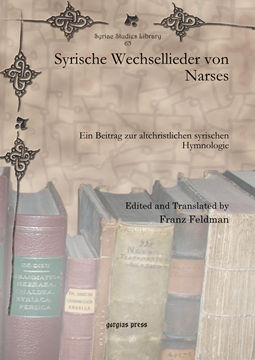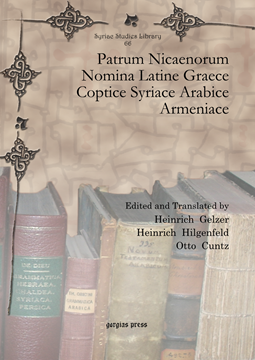Ueber und aus Reden von zwei syrischen Kirchenvätern über das Leiden Jesu
Translation and Introduction by Pius Zingerle
Series: Analecta Gorgiana 486
ISBN: 978-1-60724-954-2
In these two articles, Zingerle surveys, in German, fourteen poems from Isaac of Antioch and Jacob of Sarug. His aim is to look at how two different Syriac authors expound the same theme: the events surrounding Jesus’ crucifixion.
$41.00 (USD)
Jacob of Serugh on the Eucharist
Homilies 22 and 95
Translation and Introduction by Hugh Connolly
Series: Analecta Gorgiana 487
ISBN: 978-1-60724-955-9
In the two articles reprinted here, Dom Hugh Connolly offers an annotated English translation of two homilies from Jacob of Serugh dealing with the Eucharist (Bedjan nos. 22 and 95), as well as a short selection from homily 53.
$39.00 (USD)
The Third Part of the Ecclesiastical History of John, Bishop of Ephesus
Now First Translated from the Original Syriac
Translation and Introduction by Robert Payne Smith
Series: Syriac Studies Library 62
ISBN: 978-1-60724-961-0
Payne Smith gives an English translation of part of John of Ephesus’ Ecclesiastical History, which does not survive complete. It is one of the most significant texts for studying church history in the later sixth century in the east.
$213.00 (USD)
Essai de vulgarisation des homélies métriques de Jacques de Saroug
Translated by Jacques Babakhan
Series: Syriac Studies Library 64
ISBN: 978-1-60724-963-4
In this series of articles originally published in Revue de l’Orient Chrétien from 1912-1914, Babakhan aimed to popularize the work of Jacob of Sarug. Included are rhymed French translations of extracts from five of Jacob’s homilies.
$120.00 (USD)
Syrische Wechsellieder von Narses
Ein Beitrag zur altchristlichen syrischen Hymnologie
Edited and Translated by Franz Feldman
Series: Syriac Studies Library 65
ISBN: 978-1-60724-964-1
In this volume, Feldman gives the Syriac text of eight dialogue poems (sogyatha) by Narsai together with a German translation; various biblical narratives are presented, as well as dialogues between Cyril and Nestorius, and the Persian king and some martyrs.
$118.00 (USD)
Patrum Nicaenorum Nomina Latine Graece Coptice Syriace Arabice Armeniace
Series: Syriac Studies Library 66
ISBN: 978-1-60724-965-8
This important reference work contains the lists of those bishops that attended the Council of Nicaea according to manuscripts preserved in Latin, Greek, Coptic, Syriac, Arabic, and Armenian. The non-Latin and Greek lists are translated, and indexes are included.
$182.00 (USD)
Prolegomena in Aphraatis Sapientis Persae Sermones Homileticos
Series: Analecta Gorgiana 488
ISBN: 978-1-60724-966-5
Sasse’s foundational study of the early Syriac author Aphrahat is divided into three sections: Aphrahat’s life, his writings (including a study of the Armenian translation), and his biblical citations in comparison with the Peshitta.
$41.00 (USD)
Die Haggadischen Elemente in den Homilien des Aphraates, des persischen Weisen
By Salomon Funk
Series: Analecta Gorgiana 489
ISBN: 978-1-60724-967-2
In this volume, Funk addresses questions concerning Aphrahat’s possible relationship to Jewish sources. His method in the main part is to go through biblical passages that Aphrahat comments on and show parallels with rabbinic literature.
$47.00 (USD)
Narsai le docteur et les origines de l'école de Nisibe, d'après la chronique de Barḥadbešabba
Translated and Annotated by J.-B. Chabot
Series: Analecta Gorgiana 490
ISBN: 978-1-60724-968-9
This volume contains Chabot’s notice of a fragment published by Mingana from Barhadbeshabba dealing with Narsai and the School of Nisibis. Chabot offers a French translation of the text and a summary questioning its historical value.
$36.00 (USD)
The Diatessaron in the Syriac Acts of John / Jacob of Serug and the Diatessaron
Series: Analecta Gorgiana 491
ISBN: 978-1-60724-969-6
This volume contains two short studies on the Diatessaron and Syriac literature. Readers who study the history of the Gospels in Syriac and their reception and use in Syriac literature will find these two studies of interest.
$39.00 (USD)









